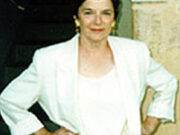Frances Mayes has achieved wide recognition for two best-selling books about her life and her second home in Italy: Under the Tuscan Sun: At Home in Italy and Bella Tuscany: The Sweet Life in Italy.
Mayes was born in Fitzgerald to Garbert and Frankye Davis Mayes. Her exact birth date is unknown. She attended Randolph-Macon Woman’s College in Virginia and obtained her B.A. from the University of Florida and her M.A. from San Francisco State University in 1975. She taught creative writing at San Francisco State University until 2001. She married her second husband, poet Ed Kleinschmidt in 1998.
Mayes published six books of poetry from 1977 to 1995: Climbing Aconcagua (1977), Sunday in Another Country (1977), After Such Pleasures (1979), The Arts of Fire (1982), Hours (1984), and Ex Voto (1995). Many of her poems explore the rich, complex landscape of her childhood home in south Georgia, a hierarchical world where class, race, and gender determine roles in small-town life. In other works Mayes writes about landscapes far removed from the South, sometimes fusing the two seemingly disparate worlds. She moves easily from exterior to interior landscapes, examining issues of identity, relationships, death, and loneliness. For Mayes, memory creates another landscape that colors the present.
Mayes brings her poetic voice to her two most popular works, Under the Tuscan Sun (1996) and Bella Tuscany (1999). The former opens with the purchase of an Italian villa outside the town of Cortona, Italy, and details its renovation and the discovery of a vibrant new culture. The work began as a blank book entitled “Italy,” where Mayes included lists of wildflowers, words, sketches, and planting advice. Under the Tuscan Sun thus became a memoir/cookbook/travel guide/renovation and gardening manual. Mayes writes in the preface that the transformation of the house and garden became a metaphor for transformations in her own life. She learned “to live another kind of life,” one far removed from the breakneck speed of her academic job and life in a modern American city. In Italy, friends and family, the beauty of a garden, and a good meal are savored. A movie version of Under the Tuscan Sun, starring Diane Lane, was released in 2003.
In Bella Tuscany, the renovation of the villa nearly complete, Mayes writes about explorations around Tuscany and growing connections to this new/old world. She also connects the process of writing to the process of living, claiming that “living in Italy, I’m especially aware of storing what I experience and see. If I ever end up rocking on the porch of a dogtrot house in the backwoods of Georgia, I aim to have plenty to visualize.”
At the heart of her work is a preoccupation with a sensual world and a need to live life moment by moment. Mayes writes in Under the Tuscan Sun: “Growing up, I absorbed the Southern obsession with place, and place can seem to me somehow an extension of the self. If I am made of red clay and black river water and white sand and moss, that seems natural to me.” She recaptures the same feelings in Italy, where she is “returned to that primal first awareness of home.”
Mayes finally turned her attention back to home with the novel Swan (2002), set in the fictitious town of Swan, Georgia, and ripe with allusions to her hometown of Fitzgerald.




